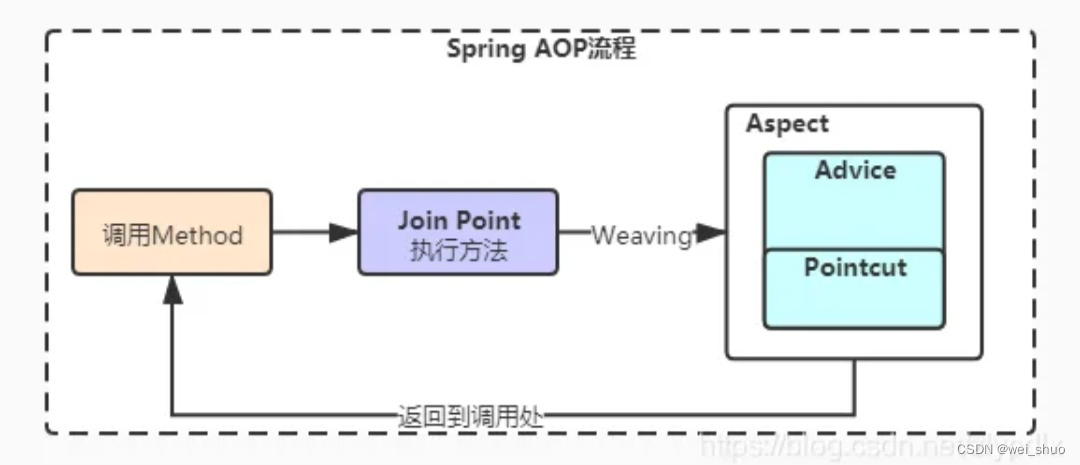
💗wei_shuo的个人主页
💫wei_shuo的学习社区
🌐Hello World !
文章目录
Sping AOP
Spring AOP:
控制反转AOP面向切面编程,通过
预编译方式和运行期间动态代理实现程序功能的统一维护的一种技术。AOP是
OOP的延续,是软件开发中的一个热点,也是
Spring框架中的一个重要内容,是
函数式编程的一种衍生范型。利用AOP可以对业务逻辑的各个部分进行隔离,从而使得业务逻辑各部分之间的
耦合度降低,提高程序的可重用性,同时提高了开发的效率

代理模式
代理模式是程序设计中的一种设计模式- 所谓的代理者是指一个类别可以作为其它东西的接口。代理者可以作任何东西的接口:网上连接、存储器中的大对象、文件或其它昂贵或无法复制的资源
代理模式分类:
- 静态代理
- 动态代理
优势:
- 真实角色更加纯粹,不用关注公共业务
- 公共业务交给代理角色,实现业务分工
- 公共业务发生扩展时,方便集中管理
劣势:
- 一个真实角色会产生一个代理,代码量会翻倍、效率降低
静态代理
角色分析:
- 抽象角色:一般会使用接口或者抽象类来解决
- 真实代理:被代理的角色
- 代理角色:代理真实角色
- 客户:访问代理对象者
- 接口
publicinterfaceRent{publicvoidrent();}
- 真实角色
publicclassHost{publicvoidrent(){System.out.println("房东房子出租");}}
- 代理角色
publicclassProxyimplementsRent{privateHost host;publicProxy(){}publicProxy(Host host){this.host = host;}publicvoidrent(){ host.rent();}//看房publicvoidseeHouse(){System.out.println("中介带你看房");}//收中介费publicvoidmoney(){System.out.println("收中介费");}}
- 客户端访问代理角色
publicclassClient{publicstaticvoidmain(String[] args){//创建房东对象Host host =newHost();//代理Proxy proxy =newProxy(host);//通过代理调用房东对象 proxy.rent();}}
动态代理
动态代理:
- 动态代理和静态代理角色一样
- 动态代理的代理类是动态生成
- 动态代理是一个接口,对应一类业务
- 动态代理可以代理多个类,只要实现一个接口
动态代理分类:
- 基于接口——JDK动态代理
- 基于类——cglib
- Java字节码——Javasist
两种类了解:
- Proxy——代理
- InvocationHandl——调用处理程序
Proxy类:生成动态代理实例
Proxy创建动态代理类的实例提供了静态方法,也是所有动态代理类的父类的方法创建方法:
//返回指定的代理实例的调用处理程序getInvocationHandler(Object proxy)//返回 java.lang.Class对象的代理类,给出了类装载器和一个阵列的接口getProxyClass(ClassLoader loader, 类<?>... interfaces)//如果指定的类是动态生成的可利用 getProxyClass法或代理类 newProxyInstance方法返回trueisProxyClass(类<?> cl)//返回指定的接口,将方法调用指定的调用处理程序的代理类的一个实例。 newProxyInstance(ClassLoader loader, 类<?>[] interfaces,InvocationHandler h)
InvocationHandl类:调用处理程序并返回结果
InvocationHandler是通过一个代理实例调用处理程序实现的接口。- 每个代理实例都有一个相关的调用处理程序。当一个方法是在一个代理实例调用,调用的方法进行编码并派遣其调用处理程序的
invoke方法方法:
//在代理实例上处理方法调用,并返回结果invoke(Object proxy, 方法 method,Object[] args)
- proxy — 调用该方法的代理实例
- method — 反射获取到的接口的方法
- args — 使用此方法时传入的参数数组
- ProxyInvocationHandler动态代理类
publicclassProxyInvocationHandlimplementsInvocationHandler{//被代理的接口privateObject target;publicvoidsetTarget(Object target){this.target = target;}//生成得到代理类publicObjectgetProxy(){//this.getClass().getClassLoader() 加载类所在位置//rent.getClass().getInterfaces() 表示代理接口//this == InvocationHandler实现类returnProxy.newProxyInstance(this.getClass().getClassLoader(), target.getClass().getInterfaces(),this);}//处理代理实例,并返回结果@OverridepublicObjectinvoke(Object proxy,Method method,Object[] args)throwsThrowable{//动态代理的本质,就是使用反射机制log(method.getName());Object result = method.invoke(target, args);return result;}publicvoidlog(String msg){System.out.println("执行了"+ msg +"方法");}}
- Client客户类
publicclassClient{publicstaticvoidmain(String[] args){//真实角色:被代理的角色UserServiceImp userService =newUserServiceImp();//代理角色:代理真实角色ProxyInvocationHandl pih =newProxyInvocationHandl();//设置代理对象 pih.setTarget(userService);//动态生成代理类UserService proxy =(UserService) pih.getProxy(); proxy.query();}}/* 执行了query方法 [Debug]使用了query方法 查询用户 */
AOP概述
提供声明式事物,允许用户自定义切面
- 横切关注点:跨越应用程序多个模块的方法或功能。即是,与我们业务逻辑无关的,但是我们需要关注的部分,就是很切关注点,如:日志,安全,缓存,事物……
- 切面(ASPECT):横切关注点被模块化的特殊对象。
- 通知(Advice):切面必须要完成的工作。
- 目标(Target):被通知对象。
- 代理(Proxy):向目标对象应用通知之后创建的对象。
- 切入点(PointCut):切面通知执行的"地点"的定义。
- 连接点(JoinPoint):与切入点匹配的执行点。
Spring实现AOP
方式一:使用Spring的API接口实现AOP
- 使用AOP织入,需要导入一个依赖包
<dependencies><dependency><groupId>org.aspectj</groupId><artifactId>aspectjweaver</artifactId><version>1.9.4</version></dependency></dependencies>
- applicationContext.xml
<?xml version="1.0" encoding="UTF-8"?><beansxmlns="http://www.springframework.org/schema/beans"xmlns:xsi="http://www.w3.org/2001/XMLSchema-instance"xmlns:aop="http://www.springframework.org/schema/aop"xsi:schemaLocation=" http://www.springframework.org/schema/beans http://www.springframework.org/schema/beans/spring-beans.xsd http://www.springframework.org/schema/aop http://www.springframework.org/schema/aop/spring-aop.xsd "></beans>
- 前置Log日志类
publicclass log implementsMethodBeforeAdvice{//method:要执行的目标对象方法//object:参数//target:目标对象@Overridepublicvoidbefore(Method method,Object[] objects,Object target)throwsThrowable{System.out.println(target.getClass().getName()+"的"+method.getName()+"被执行了");}}
- 后置AfterLog类
publicclassAfterLogimplementsAfterReturningAdvice{//returnValue:返回值@OverridepublicvoidafterReturning(Object returnValue,Method method,Object[] objects,Object o1)throwsThrowable{System.out.println("执行了"+method.getName()+"放回结果为:"+returnValue);}}
- UserService接口
publicinterfaceUserService{publicvoidadd();publicvoiddelete();publicvoidupdate();publicvoidselect();}
- UserServiceImpl接口实现类
publicclassUserServiceImplimplementsUserService{publicvoidadd(){System.out.println("增加了一个用户");}publicvoiddelete(){System.out.println("删除了一个用户");}publicvoidupdate(){System.out.println("更新了一个用户");}publicvoidselect(){System.out.println("查询了一个用户");}}
- 将UserServiceImpl接口实现类注册到Spring中,即applicationContext.xml中
<?xml version="1.0" encoding="UTF-8"?><beansxmlns="http://www.springframework.org/schema/beans"xmlns:xsi="http://www.w3.org/2001/XMLSchema-instance"xmlns:aop="http://www.springframework.org/schema/aop"xsi:schemaLocation=" http://www.springframework.org/schema/beans http://www.springframework.org/schema/beans/spring-beans.xsd http://www.springframework.org/schema/aop http://www.springframework.org/schema/aop/spring-aop.xsd "><!--注册bean--><beanid="userService"class="com.wei.service.UserServiceImpl"/><beanid="log"class="com.wei.log.log"/><beanid="agter"class="com.wei.log.AfterLog"/><!--方式一:使用原生的Spring API接口--><!--配置aop,需要导入aop的约束--><aop:config><!--切入点: execution:表达式 execution(要执行的位置 * * * * *) --><aop:pointcutid="pointcut"expression="execution(* com.wei.service.UserServiceImpl.*(..))"/><!--执行环绕增强--><aop:advisoradvice-ref="log"pointcut-ref="pointcut"/><aop:advisoradvice-ref="agter"pointcut-ref="pointcut"/></aop:config></beans>
- MyTest测试类
publicclassMyTest{publicstaticvoidmain(String[] args){ApplicationContext context =newClassPathXmlApplicationContext("applicationContext.xml");//动态代理的是接口UserService userService =(UserService) context.getBean("userService"); userService.delete();}}/* 执行结果: com.wei.service.UserServiceImpl的delete被执行了 删除了一个用户 执行了delete放回结果为:null */
方式二:自定义实现AOP
- 自定义Diy类
publicclassDiyPointCut{publicvoidbefore(){System.out.println("===========方法执行前===========");}publicvoidafter(){System.out.println("===========方法执行后===========");}}
- 将Diy类注册到Spring中,即applicationContext.xml中
<!--方式二:自定义类--><beanid="diy"class="com.wei.diy.DiyPointCut"/><aop:config><!--自定义切面:ref要引用的类--><aop:aspectref="diy"><!--切入点--><!--execution(修饰符返回值 类路径.*(..))--><aop:pointcutid="point"expression="execution(* com.wei.service.UserServiceImpl.*(..))"/><!--通知--><!-- method="before" 自定义的方法名 pointcut-ref="point" 方法执行在point切入点之后 --><aop:beforemethod="before"pointcut-ref="point"/><aop:aftermethod="after"pointcut-ref="point"/></aop:aspect></aop:config>
- MyTest测试类
publicclassMyTest{publicstaticvoidmain(String[] args){ApplicationContext context =newClassPathXmlApplicationContext("applicationContext.xml");//动态代理的是接口UserService userService =(UserService) context.getBean("userService"); userService.delete();}}/* ===========方法执行前=========== 删除了一个用户 ===========方法执行后=========== */
aop中execution 表达式(*execution(\* 包名.\*.*(..))*)
- 整个表达式可以分为五个部分:- execution(): 表达式主体- 第一个号:方法返回类型, 号表示所有的类型- 包名:表示需要拦截的包名- 第二个号:表示类名,号表示所有的类- (…):最后这个星号表示方法名,号表示所有的方法,后面( )里面表示方法的参数,两个句点表示任何参数
<!--切入点--><!--execution(修饰符返回值 类路径.*(..))--><aop:pointcutid="point"expression="execution(* com.wei.service.UserServiceImpl.*(..))"/>
方式三:使用注解实现AOP
- 创建AnnotationPointCut类
//方式三:使用注解实现AOP// @Aspect 标注这个类是一个切面@AspectpublicclassAnnotationPointCut{//后置增强@Before("execution(* com.wei.service.UserServiceImpl.*(..))")publicvoidbefore(){System.out.println("======方法执行前======");}//前置增强@After("execution(* com.wei.service.UserServiceImpl.*(..))")publicvoidafter(){System.out.println("======方法执行后======");}//在环绕增强中,可以给一个参数,代表要获取处理切入的点@Around("execution(* com.wei.service.UserServiceImpl.*(..))")publicvoidaround(ProceedingJoinPoint jp)throwsThrowable{System.out.println("======环绕前======");//执行方法Object proceed = jp.proceed();System.out.println("======环绕后======");}}
- 将AnnotationPointCut类注册到Spring中,即applicationContext.xml中
<!--方式三--><beanid="AnnotationPointCut"class="com.wei.diy.AnnotationPointCut"/><!--开启注解支持--><!-- JDK(默认 proxy-target-class="false") cglib(proxy-target-class="true") --><aop:aspectj-autoproxyproxy-target-class="true"/>
- MyTest测试类
publicclassMyTest{publicstaticvoidmain(String[] args){ApplicationContext context =newClassPathXmlApplicationContext("applicationContext.xml");//动态代理的是接口UserService userService =(UserService) context.getBean("userService"); userService.delete();}}/* 执行结果: ======环绕前====== ======方法执行前====== 删除了一个用户 ======环绕后====== ======方法执行后====== */
🌼 结语:创作不易,如果觉得博主的文章赏心悦目,还请——
点赞👍
收藏⭐️
评论📝
冲冲冲🤞
版权归原作者 wei_shuo 所有, 如有侵权,请联系我们删除。